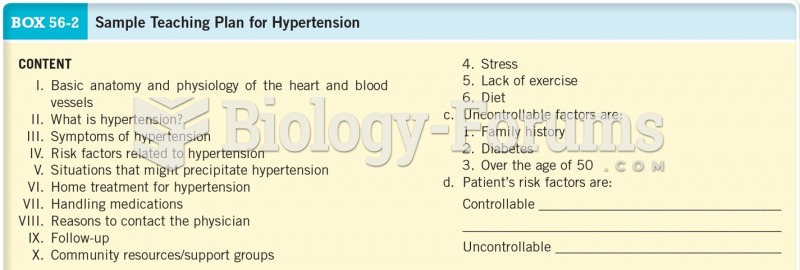Answer to Question 1
Correct Answer: 4
Rationale 1: The fact that the client's father had hypertension and lived to be 90 years old does not mean that the client will have the same experience; the client is in denial.
Rationale 2: Increasing physical activity is an important lifestyle modification for controlling hypertension.
Rationale 3: Implementing lifestyle modifications might eliminate the need for pharmacotherapy, so the client might not have to take medication right away.
Rationale 4: Limiting intake of alcohol and discontinuing the use of tobacco products are important nonpharmacologic methods for controlling hypertension.
Global Rationale: Limiting intake of alcohol and discontinuing the use of tobacco products are important nonpharmacologic methods for controlling hypertension. The fact that the client's father had hypertension and lived to be 90 years old does not mean that the client will have the same experience; the client is in denial. Increasing physical activity is an important lifestyle modification for controlling hypertension. Implementing lifestyle modifications might eliminate the need for pharmacotherapy, so the client might not have to take medication right away.
Answer to Question 2
Correct Answer: 3,4
Rationale 1: A calcium supplement would be appropriate in hypocalcemia, not hyperkalemia.
Rationale 2: Potassium supplements would be appropriate for hypokalemia, not hyperkalemia.
Rationale 3: Hypotonic fluids are often used in the treatment of hyperkalemia.
Rationale 4: Buffering agents are often used in the treatment of hyperkalemia.
Rationale 5: Citrus fruits are high in potassium and should not be included in the plan of care for a client with hyperkalemia.
Global Rationale: Hypotonic fluids and buffering agents are often used in the treatment of hyperkalemia. A calcium supplement would be appropriate in hypocalcemia, not hyperkalemia. Potassium supplements would be appropriate for hypokalemia, not hyperkalemia. Citrus fruits are high in potassium and should not be included in the plan of care for a client with hyperkalemia.







